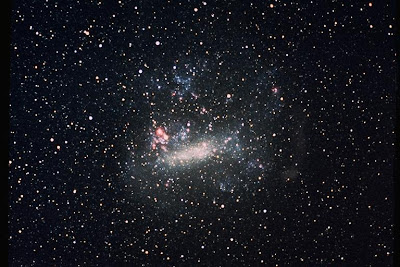Dark matter is still one of the biggest mysteries in the universe, in addition to dark energy. It consists of matter we cannot see, but we know exists because of its gravitational effect, just like ordinary observable matter. Over time, scientists gathered clues about the identity of dark matter, and a couple of particles are currently under investigation to find out whether one of them forms the illusive dark matter. New research from NASA closes in on the true particle of dark matter, by excluding some postulated candidates. Slowly, but steadily, the mystery of one of the universe's biggest secrets is being unravelled.
Dwarf galaxies
Traditionally, astronomers attempt to find dark matter by looking at so-called dwarf galaxies. Small galaxies, which nevertheless contain billions of stars, are excellent study objects to find dark matter, because they contain a relatively high amount of the stuff. Scientists measure gamma radiation, a form of electromagnetic radiation similar to visible rays of light, to determine the make-up of a galaxy. When particles interact, they often emit gamma rays. While dark matter may be emitting no electromagnetic radiation at all, scientists do hope to find a signal from somewhere in the radiation spectrum coming from a dwarf galaxy, that reveals the existence of dark matter.
NASA
By studying a series of dwarf galaxies orbiting our own Milky Way, NASA found clues that tell us something about what gamma rays coming from dark matter should look like. Because the data from all the observed galaxies were combined using a newly developed tool, the scientists increased the statistical chance that radiation is coming from dark matter. Because 80 percent of all matter is of the dark variant, we would expect to find its signals, when we know what to look for. Therefore we exclude known radiation patterns coming from matter we can actually observe. According to NASA, their study greatly improves the sensitivity by which patterns can be detected from the gamma ray background, and future studies should increase the data pool to further strengthen the data.
True identity
Despite their efforts, NASA still does not know what dark matter actually is. It does not seem likely we will find it anytime soon, but by excluding particle candidates, we are getting closer to unravelling the mystery. Scientists already know a great deal about what the characteristics of a dark matter particle should be, and they postulated a so-called Weak Interacting Mass Particle (WIMP) theory. The question then becomes which one of the candidates is the WIMP that creates the gravitational effect we can measure, but cannot see. Previous research has shown a dark matter WIMP is likely to be relatively heavy, while other scientists have created a map of all the dark matter that surrounds us.
Dwarf galaxies
Traditionally, astronomers attempt to find dark matter by looking at so-called dwarf galaxies. Small galaxies, which nevertheless contain billions of stars, are excellent study objects to find dark matter, because they contain a relatively high amount of the stuff. Scientists measure gamma radiation, a form of electromagnetic radiation similar to visible rays of light, to determine the make-up of a galaxy. When particles interact, they often emit gamma rays. While dark matter may be emitting no electromagnetic radiation at all, scientists do hope to find a signal from somewhere in the radiation spectrum coming from a dwarf galaxy, that reveals the existence of dark matter.
NASA
By studying a series of dwarf galaxies orbiting our own Milky Way, NASA found clues that tell us something about what gamma rays coming from dark matter should look like. Because the data from all the observed galaxies were combined using a newly developed tool, the scientists increased the statistical chance that radiation is coming from dark matter. Because 80 percent of all matter is of the dark variant, we would expect to find its signals, when we know what to look for. Therefore we exclude known radiation patterns coming from matter we can actually observe. According to NASA, their study greatly improves the sensitivity by which patterns can be detected from the gamma ray background, and future studies should increase the data pool to further strengthen the data.
True identity
Despite their efforts, NASA still does not know what dark matter actually is. It does not seem likely we will find it anytime soon, but by excluding particle candidates, we are getting closer to unravelling the mystery. Scientists already know a great deal about what the characteristics of a dark matter particle should be, and they postulated a so-called Weak Interacting Mass Particle (WIMP) theory. The question then becomes which one of the candidates is the WIMP that creates the gravitational effect we can measure, but cannot see. Previous research has shown a dark matter WIMP is likely to be relatively heavy, while other scientists have created a map of all the dark matter that surrounds us.
 |
| The Magellanic cloud, a galaxy close to our own Milky Way. With around 30 billion stars, it is regarded as a dwarf galaxy, though not all astronomers agree.
Source: http://betastuffs.blogspot.gr
|

Δεν υπάρχουν σχόλια:
Δημοσίευση σχολίου